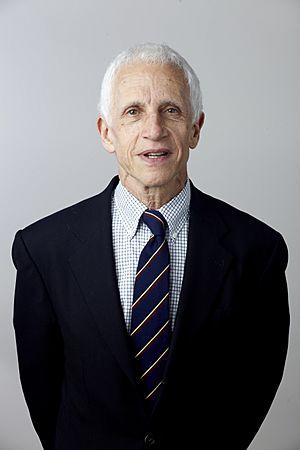Stephen C. Harrison facts for kids
Quick facts for kids
Stephen Harrison
|
|
|---|---|

Stephen Harrison in 2014, portrait via the Royal Society
|
|
| Alma mater | Harvard University (BA, PhD) |
| Spouse(s) | Tomas Kirchhausen |
| Scientific career | |
| Notable students | Xiaojiang Chen |
Stephen C. Harrison is a very important scientist. He teaches at Harvard Medical School. He also leads a special lab at Boston Children's Hospital. He studies how tiny parts of living things work. He is also a researcher for the Howard Hughes Medical Institute.
Contents
Education and Early Career
Stephen Harrison studied chemistry and physics at Harvard University. He earned his first degree in 1963. After that, he was a special fellow at a lab in Cambridge, England.
In 1967, he earned his PhD in biophysics from Harvard. He continued his research there. He became a professor at Harvard in 1971.
Amazing Discoveries in Science
Stephen Harrison's research looks at the structure of proteins. Proteins are like tiny building blocks inside all living things. His work has helped us understand many things.
He has learned about how viruses are built. He also studies how DNA and proteins recognize each other. His work helps us understand how cells send signals.
Studying Viruses Up Close
Harrison is a leader in structural biology. This field looks at the shapes of tiny parts of living things. He is famous for studying viruses and their proteins. He uses a method called crystallography. This helps him see the exact shape of these tiny parts.
He started by studying a plant virus in 1978. It was called tomato bushy stunt virus. Later, he studied more complex human viruses. These included the outer shell of human papillomavirus. He also studied parts of the dengue virus and HIV.
Fighting HIV with Science
Stephen Harrison led a team that studied HIV. This team worked at the Center for HIV/AIDS Vaccine Immunology (CHAVI). They received a lot of money from the National Institute of Allergy and Infectious Diseases.
Their goal was to find ways to create an HIV vaccine. They worked to understand the challenges. They also designed and tested new vaccine ideas.
Important Science Groups
Stephen Harrison is a member of many important science groups. These include:
- American Academy of Arts and Sciences
- National Academy of Sciences
- American Philosophical Society
- European Molecular Biology Organization
- American Crystallographic Association
- American Association for the Advancement of Science
Awards and Honors
Stephen Harrison has received many awards for his amazing work. Some of these include:
- 1982: Ledlie Prize from Harvard University
- 1988: Wallace P. Rowe Award
- 1990: Louisa Gross Horwitz Prize (with Don Wiley and Michael Rossmann)
- 1997: ICN International Prize in Virology
- 2001: Paul Ehrlich and Ludwig Darmstaedter Prize (with Michael Rossmann)
- 2005: Bristol-Myers Squibb Award for Infectious Diseases Research
- 2006: Gregori Aminoff Prize in Crystallography (with David Stuart)
- 2011: William Silen Lifetime Achievement in Mentoring Award
- 2014: Elected as a Foreign Member of the Royal Society of London
- 2015: The Welch Award in Chemistry
- 2015: Honorary Doctorate in Medicine from the University of Milan
- 2018: 48th Rosenstiel Award for his research on proteins and viruses
Personal Life
Stephen Harrison is married to Tomas (Tom) Kirchhausen. Tom is also a professor at Harvard Medical School. They met in 1978. They have been together since 1979.

